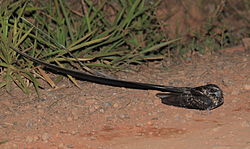| Long-trained nightjar | |
|---|---|
 | |
| male at Tremembé, São Paulo state, Brazil | |
 | |
| female at Tremembé, São Paulo state, Brazil | |
| Scientific classification | |
| Kingdom: | Animalia |
| Phylum: | Chordata |
| Class: | Aves |
| Clade: | Strisores |
| Order: | Caprimulgiformes |
| Family: | Caprimulgidae |
| Genus: | Hydropsalis |
| Species: | H. forcipata |
| Binomial name | |
| Hydropsalis forcipata (Nitzsch, 1840) | |
 | |
| Synonyms | |
| |
The long-trained nightjar (Hydropsalis forcipata) is a species of nightjar in the family Caprimulgidae. It is found in Argentina and Brazil. [2]








